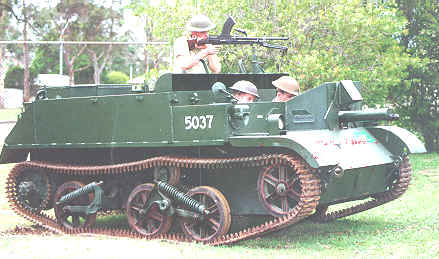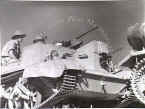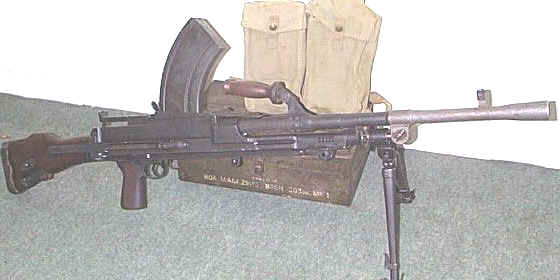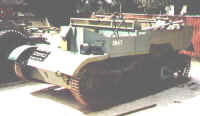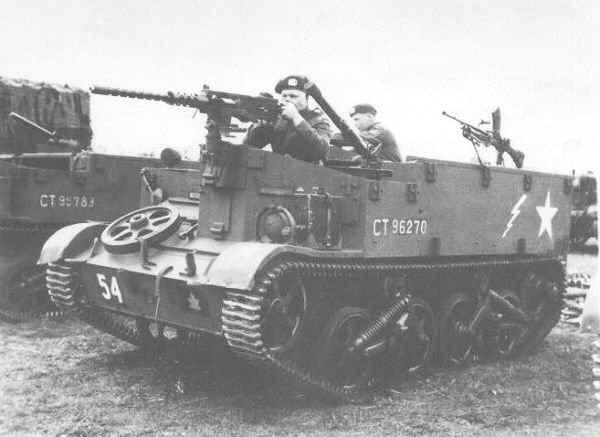 |
|
|||
|
|
||||
|
|
This Bren Carrier is on display at the Infantry Centre Singleton NSW |
|
What follows is drawn from http://www.universalcarrier.org |
| History of the Carrier by Nigel Watson Dundee, Scotland | ||
| The first Machine Gun
Carrier introduced into British service was produced by Vickers in 1936
and became the prototype for the Machine Gun and Bren Carriers.
Designated the Carrier, Machine Gun, No.1, Mk I, it carried a
crew of three, dispensing with the idea of carrying an independent
machine gun team and replacing it with the idea that the vehicle and
crew were the machine gun team, able to operate with or independent from
the vehicle.
Early 1937 saw the testing of the General Purpose Vehicle. This was the earlier Carrier Machine Gun Experimental (WD No.T1583 and Reg. No. BMM 939) which had its superstructure altered to form a projecting gunners compartment at the front, but with a grooved rail around its top edge, in which was enclosed a four-wheeled mount for the Boyes AT Rifle. The operator of the rifle was able to traverse the gun 180 degrees. It also was armed with a Bren LMG in the usual position. This vehicle was never adopted but is importance in the development of the carrier because it set the form for the projecting front section of armour in front of the gunner. As the ability for a tracked type of vehicle to carry 3 inch Mortar had been realised in the late 1920`s with Carden-Loyd's Carrier, 3 inch Mortar, Vickers built a pilot model for the mortar carrying role. A Carrier, Machine Gun No.1 MkI was fitted with special storage racks for the mortar and mortar bombs. To be used, the mortar was dismounted from the carrier and operated separately by its crew who had also been transported in the same vehicle.The Carrier, Machine Gun, No.2, MkI went into service in late1937. Originally fitted with Vickers .303 Medium Machine Guns, these Carriers were later equipped with the .303 Bren Light Machine Gun and/or a Boys Anti-Tank Rifle. In 1938 a Carrier, Machine Gun, No.2, MkI was fitted with a 2 pounder MkI X or Mk X Anti-Tank Gun mounted to fire forward through a shield. (WD/Reg.No. T2335/FME890).Australia had laid down a policy for mechanisation of its forces back in 1930, but it wasn't until mid 1939 that she purchased a Carrier, Bren, No.2 Mk 1 (T2831) from Britain which was to become the pattern for a production of locally made carriers. At almost the same time New Zealand took delivery of six Carriers, Bren, No.2 Mks I & II. They were issued two per military district and took part in the Composite Mounted Rifle Regiments annual camp where they were received with mixed enthusiasm. One crew fixed a lance to theirs and took part in the customary tent pegging competition! History does not relate how successful they were!The Carrier, Bren No.2 MkI & Mk II entered service in 1938 and although similar to its predecessor included some major alterations to the design. The main modifications were to the front armour where a gunners projecting shield was formed with a firing slot and hinged flap to assist the firing of the Boyes AT Rifle now being issued. Protective shields for the vision ports were provided. However the main significant change made was to the front idler wheel. Its position was moved higher on the side hull. This produced a steeper track angle at the front and gave the vehicle its characteristic "tail down" position. The higher idler also necessitated the forming of a curved section of front mudguard over this portion of track; this was to remain throughout the Carrier models with the Loyd the only exception. They were issued to the British Infantry and first encountered action in France and the Low Countries. After Britain's withdrawal of her troops from France in 1940 many of these Carriers were captured by the Germans who altered them to suit their particular requirements. So many were captured, and subsequently altered, that the Germans even gave them their own vehicle designations. Having established a effective design for the carrier, its development focused on modifications to meet a variety of specialist rolls the vehicle was required to undertake. The Carrier, Scout, MkI appeared in service in 1938. Designed as scout machines for the mechanised cavalry and light tank divisions, it had provision for carrying the No.11 wireless set and (apart from the pilot model) had high sided armour enclosure for the wireless operator's behind the driver.There next followed the Carrier, Cavalry MkI, which was developed to carry six men who sat on either side of the rear compartments facing the engine. This was not a popular vehicle as its occupants were not protected from enemy fire. The Loyd Carrier was developed and came into service in 1940. It was a simple container, armoured if required, with engine at the rear driving the sprockets at the front. This configuration allowed easy access to the vehicle via the rear and was much favoured by the troops.Carrier, Armoured, OP No.1, MkI was produced for the Royal Artillery as a forward observation post. It contained a No.11 wireless set, a cable drum on the rear cover plate and an adjustable shutter over the gunners firing slot to facilitate the use of binoculars. Based on the Carrier, Scout MkI it was to be the beginning of a line of Observation Post (OP) carriers whose role continues even today.
The War Department began to realise that it would be more economical to produce a standard vehicle which could be easily altered to suit the various roles required by the army. Thus, in 1940 the Carrier, Universal No.1 MkI appeared; this vehicle was to become one of the most widely used armoured vehicles of World War II. It was to lend itself to a huge number of variants, some more fanciful than others. Bren and Scout Carriers were upgraded during the war to the "universal" standard; many of these Carriers received "in the field" alterations which included the mounting of heavier machine guns like the American .30 in and .50 in Brownings.Carrier, Universal No.1 MkI featured a riveted hull with complete armour protection around the whole of the front and rear compartments. Most were provided with a angled hinged flap on the gunners compartment side armour to assist the drivers view. The third crew member sat in the rear compartment behind the driver and his compartment had timber or rubber firing rests fixed to the armour edges. The now well established carrier suspension, the Horstmann unit, with a double and single bogie wheel configuration each side, was used. Steering was by way of a steering wheel on the right which when rotated supposedly up to about 10 degrees off centre, warped or bowed the track so that a large radius turn could be accomplished without the use of brakes. Further than that and the steering wheel operated the brakes on a side which resulted in a sharper, quicker turn. The opposite rear compartment was used for stowage and included a locker for crew belongings, brackets for Bren Gun tripod etc. Various models of the MkI were produced which included minor upgrades from the Ford V8 65 bhp engine in the No.1 MkI to the Ford V8 85 bhp engine in the Canadian built No.3 MkI*.A large number of variants based on the MkI were developed. Many were destined to be only prototypes but a few were developed and some of these saw action during the war. It wasn't until the Carrier, Universal No.1 Mk II came out in 1943 that alterations to the stowage and crew seating were made and improved upon. It also featured a welded waterproof hull. Again stowage types were dependent on the role of the vehicle. The position of the 2 in mortar from the engine deck on the Mark I into the gunners compartment on the Mark II was a major improvement along with the re-siting of the crew locker to the rear of the carrier making more room for crew and/or equipment. Further stowage lockers were provided above each petrol tank.The Carrier, Universal No.1 Mk III was launched soon afterwards and featured further stowage alterations, engine deck modifications and a remodeled division plate between the front and rear compartments. The Carrier, Armoured, OP (Observation Post), No1, MkI had appeared about 1939 being based on the Carrier, Scout MkI. The later Carrier, Armoured, OP, No.1 Mk II was constructed on the Universal Carrier MkI riveted hull with a variety of modifications to the engine cover, front armour and stowage details for the cables reels and telephone equipment. The Carrier, Armoured, OP No.1 Mk III followed and was the first to be based on the welded hull of the Universal Carrier Mk III. Three other models were introduced with different engines and stowage layouts accommodating the extra equipment carried.The Loyd Carrier had made its debut in 1940 and was the only carrier of that time to be designed as a troop carrier, being able to accommodate 8 men. It was initially only used in this role by the British Army, but it wasn't long before it became clear the demand for this type of vehicle to tow trailers and artillery as well as carry the crews. Despite the fact that most Universal Carriers manufactured in/after 1943 were fitted with the Stacey Towing Attachment, for them to be able to tow the 6-pdr anti-tank gun over short distances, the Loyd Carrier was preferred by the troops for this job with its less complicated tiller operated steering. From 1943 onwards there followed a succession of Loyd carriers developed for specific roles. A wide range of prototypes and trial models based on the Loyd were also produced, many of which were destined for further alterations or other countries. Late in 1940 experiments were being carried out with flame projecting equipment fixed to the side of a Carrier. Named the "Adey-Martin Drain Pipe" it was tested by the Welsh Guards and became the prototype for the Ronson Flame Projector.The Carrier, Anti-Tank, 2-pdr (Aust) underwent serious trials in August and September 1941, and in February 1942 undertook gunnery tests. The results were impressive with twelve hits registered on a moving target out of 15 rounds fired and all this at a range of 800 yards! This resulted in an order being placed for 200 with the first of these being delivered in May 1942. Development of stronger armour on the part of the Germans unfortunately rendered the 2 pdr gun ineffective against it, so the vehicle was virtually redundant before it entered service. The result was that they were used for training with a number allocated to the Volunteer Defence Corps. They were declared obsolete in 1946. In 1942 a Universal Carrier MkI was converted to carry a 3 in mortar, its ammunition and crew. The mortar was stowed at the back along with its cleaning rod, oil can and mounting. The base plate was carried on the front of the Carrier on earlier models and on the rear later on. This model was designated Carrier, 3 in Mortar, No.1, MkI; it had the riveted hull of the Universal Carrier MkI and carried a crew of five including the driver and front gunner. There followed seven more official models with different engines and modified stowage arrangements. The Carrier, 3 in Mortar, No.1 Mk II was the first of the models to use the welded hull of the Universal Carrier Mk II.As the British carrier development had, their Australian counterparts produced the Carrier, 3-inch Mortar (Aust). Designed around the concept of the 2 pdr Anti-Tank Carrier, the mortar was fixed in the centre of a rear compartment on a revolving turntable surrounded by armoured stowage for the mortar bombs, tools and crew equipment. The 3 mortar crew sat in the `fighting` compartment as this rear compartment was called, whilst the driver sat on the right of the front section with the engine alongside him. After successful trials in April 1942, 400 of these carriers were ordered. By October 1942 five of these carriers were produced, and by the end of June 1943 the last of them came off the production line. A change in requirement by the army prevented more being made and subsequently the 400 produced were shipped abroad as aid during the latter part of the war. The Carrier, Medium Machine Gun No.1 MkI commenced its career in 1943 with the Motor Machine Gun Battalions. This was the original Universal Carrier MkI converted for the MMG role. Following on from this seven other models were introduced with different specifications for engines as well as stowage and hulls used. The Carrier, Machine Gun, No.1 Mk II adopted the Universal Carrier Mk II welded hull.Towards the end of 1943 the Wasp MkI (FT, Transportable, No.2 MkI) production was completed. A new flamethrower nozzle was fitted to the Wasp Mk II (FT, Transportable, No.2 Mk II). The Wasp Mk IIC (FT, Transportable No.2 Mk IIC) was developed for the Canadian Army and became the next production model with a new plastic armour being fitted for protection against the German 7.92 AP shells as well as 20mm fire. Three Wasps were sent to Russia for their evaluation in February 1945. The success of the Loyd Carrier in so much as its ability to carry more troops and supplies as well as tow anti-tank guns over longer distances prompted the Canadian Department of Munitions and Supply to back Ford Motor Company of Canada in the building of a new type of carrier to replace the tired Loyds. The Carrier, Windsor, MkI* was introduced in 1943 and used mainly all Loyd parts. It was designed using the Universal Carrier concept but with an extended hull. It incorporated two double bogie units of the same type as on the Universals. Several models were developed for different roles and to accommodate new weapons etc.At the same time America was attempting to design a better vehicle also to replace the Loyd and Universal Carriers that were in service at the time. Designated originally Cargo Carrier T16, it was re-designated Carrier, Universal T16 MkI to keep in line with the British nomenclature; but also perhaps to set it apart from the American Half-Track development numbers which were T1 - T19 (before they too were changed to the M series!), it was to take over the same roles as the Loyds and Universals. Production of 30,000 for Britain was authorised in 1942. However only a few were actually built and put into service towards the end of the war. Some were used in operations with the Australians in the Far East. An upgraded model, Carrier, Universal T16E2 Mk II was produced with the bogie units positions altered to provide better loading over them and to provide a smoother ride. During 1944 an improved model of the Carriers, Machine Gun, (Aust) No.2 and 2A was designed. Called the Carrier, MG (Aust) No.3 or LP3 it contained a new form of steering based on track displacement but unlike its British predecessors used the front idler wheel to bow the track. Apart from the Machine Gun Carrier LP1, all the other LP Carriers used a welded hull.In 1942 the British asked The Department of Munitions and Supply in Ottawa to develop a two man snow machine to be used in operation "Jupitor". Operation "Jupitor" was a plan to attack Europe from the north, beginning over the arctic terrain of Norway. A prototype was manufactured within 3 months and production of the Canadian MkI Armoured Snowmobile began in early 1944. They were made by Ferand and Delorme Ltd with them producing 410 of them. 396 went to Britain, 3 to Russia and the remaining 11 were retained by Canada. 10 were sent to 5th Canadian Armoured Brigade in Italy and were used from January 20th to February 7th 1945. They also proved themselves very capable for towing anti-tank guns. Another development closely allied to the scout carrier concept was a two man tracked and armed reconnaissance vehicle, called the `Tracked Jeep`. It was to correspond to the Light Utility Willys Model MB 1/4 ton 4x4 "Jeep" but possess the additional features of light armour, improved cross country performance, built in radio equipment and extremely low silhouette. Requested in mid 1943 a prototype was tested in 1944. It didn't see production.Projected in the latter part of 1944 an experimental carrier, known as "Tugboat", was developed based on the Carrier, Universal T16 MkI. It was designed to combat anti-personnel mines which were usually laid to prevent mine clearing teams lifting the anti-tank mines. It had twin tracks and their corresponding suspension units and bogie wheels and double sprockets. The last true descendent of the carrier line was the Oxford Carrier. Built in 1944 only a few saw service. Designated Carrier, Tracked, CT20 (Carrier, Oxford MkI) it followed the principle requirements that were laid down for the Universal Carriers previously. Six carriers were eventually proposed as replacements for the Oxford but most only reached the experimental and prototype stages. Designed by companies such as Loyd, Rolls Royce and Vickers-Armstrong none were to go into full production.The Rolls Royce designed Carrier, Tracked FV401 (Carrier, Cambridge) appeared as a pilot model for trials in 1950. The OP version, the Carrier, Armoured, OP No.4 (FV402) was an FV401 converted with an armoured hatch over the crew compartment. ConclusionThe versatility of the Universal Carrier was its success. No other vehicle during World War 2 carried out the variety of roles which was asked of the Carrier. It fulfilled a requirement which was sought after during World War 1 but which technology of the time was unable to produce. Loved by many who encountered her, hated by others, spoken about fondly by her drivers and complained about by others, this small armoured tracked vehicle was driven by soldiers from every nation involved in the conflict between 1939 and 1945. |
||
|
A BRIEF HISTORY OF THE T-16 CARRIER |
||
| by Hanno Spoelstra Hillegom, The Netherlands | ||
| The
U.S. response to a British request to manufacture carriers was the T-16.
Re-engineered by Ford USA, it was a different beast in many ways.
The U.S. T-16 Carrier was an interesting answer to some of the known design problems inherent in the initial British genus and derivatives. After several years of hard use in varying climates and environments, the inherent weaknesses in the basic carrier design had become known: rear axles prone to failure under sustained load, a steering system which required constant adjustment and which wore out brake shoes at a prodigious rate, and suspension and track failures under high loads. In addition, it had been found that the original 221cubic inch Ford engine and its six volt electrical system was not reliable or strong enough to perform the tasks demanded of the carrier under battlefield conditions. For example, the weight of towing a six-pounder antitank gun and the carriage of its crew and stores frequently wore out drive train components and made for unsafe handling.
All of these shortfalls were addressed when the engineering staff at Ford of U.S.A. were tasked with creating an 'all-American' version of the now-ubiquitous universal carrier. The result was a fascinating hybrid! Despite the fact that no vehicle like the Universal Carrier was ever adopted by nations other than Britain and the Commonwealth, the type remained immensely popular with those armies and to meet the continuing demand the United States was drawn into the production programme. The US Tank Committee, after discussion with industry, agreed to produce the vehicles to the same performance specs, but with US engineering. A Ford Motor Company design was accepted and the (Joint) British Tank Mission placed orders under the Lend-Lease Agreement for 30,000 carriers under the American designation T16. As it was procured strictly for Lend-Lease, and since there was never any intent for US use, the "T" designation was retained instead of an "M" number being assigned.Ford's expertise in mass-production techniques was applied to the full during WW2. Production engineering improvements ranged from redesigning parts to facilitate easier manufacture and reduction of assembly time, and purpose-designed tooling to save time on manufacturing and assembly operations. Surprisingly, most of Ford's war production was non-automotive, but the basic carrier design was a prime candidate to be re-engineered for mass-production and reliability. As a result, Ford's Sommerville plant won the Army/Navy 'E' Award for production efficiency displayed on the Universal Carrier contract. The principal changes to the design involved a controlled differential steering system (discarding the track warping system devised by Vickers-Armstrong), the Ford Mercury engine, a different bogie system (with an extra road wheel added), a longer, redesigned and simplified welded hull structure, and refinement of the track and suspension (like pressed steel disk road wheels). A Fighting Vehicle Proving Establishment report on six pre-production models revealed problems with oil-cooling, failure of the tapered roller bearing in the suspension at 2,200 miles, and a loss of efficiency in the steering brakes due to the ingress of mud. These were all corrected in the next six vehicles, and it was subsequently stated that 3,500 production machines had left the factory and were awaiting shipment.From March 25, 1943 until 1945, Ford's Sommerville plant near Boston, Massachusetts, produced a total of 13,893 T16s. Production seems to have been slow in getting under way and many were delivered (too) late in the war to see action. However, during WW2 T16s were allocated to British and Commonwealth formations in Northwest Europe, where they were designated the Carrier, Universal, T16, Mark I. By June 1944 Canada had put the T16 into use towing the 6-pdr AT gun and as a 4.2-inch Mortar Carrier. Its benefit as a heavy load carrier/tower lay in its more robust controlled differential rear axle and suspension, as well as its more reliable Ford Mercury engine. Great Britain received only a modest number, most of which saw service in post-war years. It seems they were not popular in the UK. The US showed no interest in the type, although it was said that they were considering a lighter, narrower version for use in jungle warfare. Lend-Lease supplies of Universal Carriers to the Soviet Union included 96 T16s from the USA, but no details are known about their use. |
||
T16:
Engine: Ford V8 petrol, model GAU370, 239 cid, 100 bhp at 3,800 rpm. |
